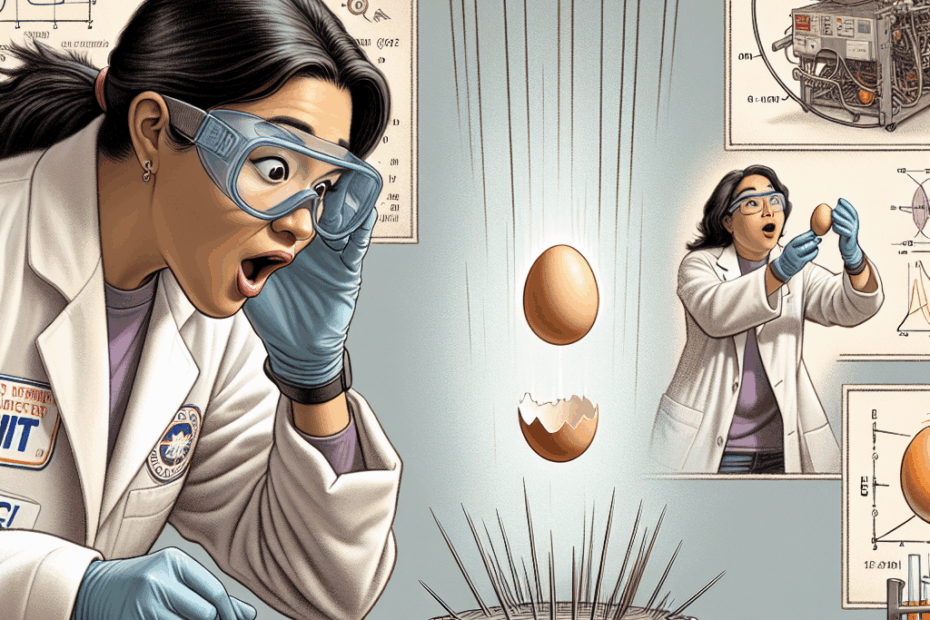“`html
Cracking the Code: Why Eggs Break Less When They Land Sideways
Hey everyone, John here! Today, we’re diving into some fascinating research that turns common sense on its head. We’re talking about eggs! Yes, those breakfast staples that we all know and (sometimes) love to drop.
For years, the popular belief, even supported by some science communicators and AI models like ChatGPT, has been that eggs are more likely to survive a fall if they land on their end. But guess what? A team of researchers at MIT has cracked that myth wide open!
The Great Egg Drop Experiment
This isn’t just some kitchen experiment gone wild. This is serious science! These researchers conducted a thorough study to determine whether eggs break more easily when landing on their pointy ends versus their sides. And the results? Drumroll, please…
Eggs are actually less likely to crack when they land on their side! Mind blown, right?
Lila: John, that’s so weird! I always thought the round part was weaker. How is that even possible?
That’s a great question, Lila! Think of it like this: imagine trying to balance a book standing upright on its spine versus laying it flat on a table. The spine has a tiny contact area, so it’s unstable and easily tipped over. The flat position distributes the weight more evenly, making it more stable. In a similar way, the side of the egg distributes the impact force over a larger area, reducing the stress on any single point.
Why the Misconception?
So, if it’s wrong, why has this idea been so prevalent? That’s what I’m wondering as well. It could be because the pointy end of an egg looks stronger, or that it seems like the more stable point of impact. It might even be due to how chickens lay eggs (vertically, typically pointy-end first!). Regardless, this is a perfect example of how even widely accepted “facts” can be incorrect.
What Does This Mean for You? (Probably Not Much, But Still Cool!)
Okay, so knowing this probably won’t change your life drastically. You’re not suddenly going to become an egg-dropping expert or anything. But it does illustrate a really important point about science: always question assumptions and test your hypotheses!
Here are some key takeaways from this egg-cellent research:
- Popular science isn’t always right: Just because something is widely believed, doesn’t make it true.
- Experimentation is key: Don’t just take someone’s word for it, test things out yourself!
- Even simple things can be surprising: There’s always something new to learn, even about everyday objects.
Real-World Applications (Maybe?)
While this research seems purely academic, you never know where it might lead. Perhaps packaging designers could use this information to better protect fragile items during shipping. Or maybe roboticists could use this understanding of eggshell strength to design more robust robotic arms. The possibilities are endless (well, maybe not endless, but you get the idea!).
Lila: So, John, could this help with designing better helmets, too?
That’s an interesting thought, Lila! While eggshells and helmets aren’t exactly the same, the principle of distributing force is definitely relevant. Helmet designers already focus on spreading impact over a wider area to protect the head. This egg research reinforces that idea and could potentially inspire new approaches to energy absorption and impact resistance in protective gear.
The Moral of the Story
The big picture here is about challenging assumptions and staying curious. We should question what we think we know and always be open to new information, even if it seems counterintuitive.
From my perspective, this egg study is a reminder that scientific inquiry can reveal unexpected truths about even the most mundane aspects of our world. It’s a testament to the power of observation, experimentation, and critical thinking.
Lila: Wow, John, I never thought I could learn so much about eggs! I guess I’ll think twice before dropping one again (or at least make sure it lands on its side!). It makes me excited to learn even more about science and how the world works!
This article is based on the following original source, summarized from the author’s perspective:
Yolk’s on you – eggs break less when they land
sideways
“`
